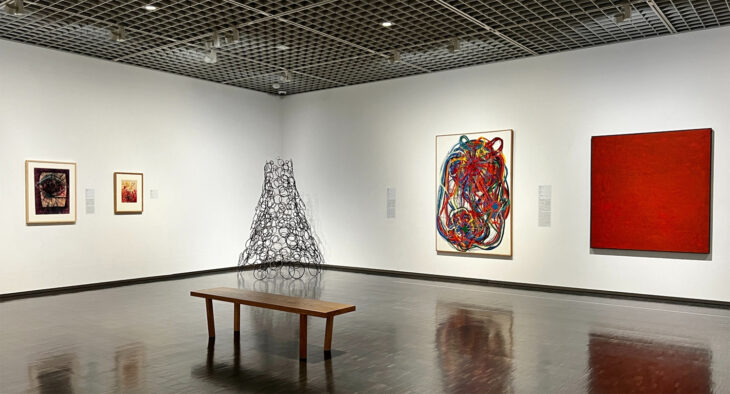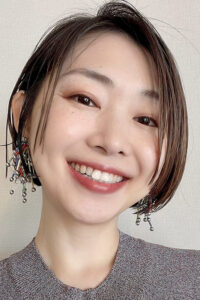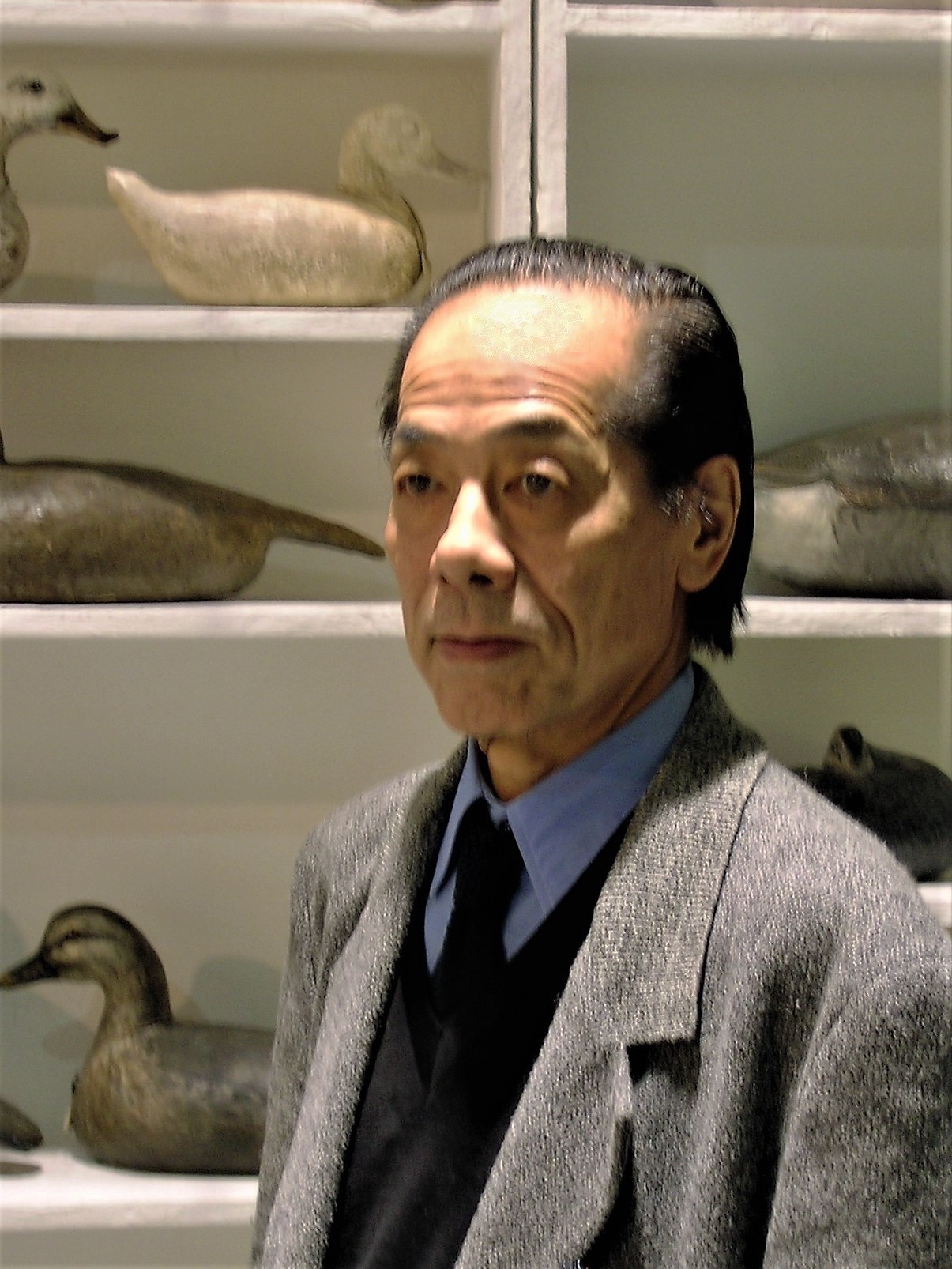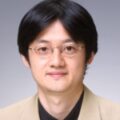Why is the National Museum of Modern Art, Tokyo holding the exhibition “Women and Abstraction”?
Fukushima Natsuko, Executive Editor, Tokyo Art Beat
An editor of Tokyo Art Beat speaks to the people in charge about the rediscovery of female artists and gender balance in the collection.
The exhibition “Women and Abstraction” was realized by a team of six people
A small exhibition “Women and Abstraction” (September 20 to December 3, 2023) is currently being held at Gallery 4, which displays the collection of the National Museum of Modern Art, Tokyo (MOMAT). This is an ambitious exhibition that introduces a number of works from the museum’s collection by women artists who have worked with abstract expression from the immediate postwar period to the present day.
This exhibition is a reexamination and curation of works from the collection, including artists who have rarely been introduced to the public, as well as notable artists who are rapidly being reevaluated, and artists who have already established an international reputation, such as Kusama Yayoi (1929–) and Tanaka Atsuko (1932–2005). Tokyo Art Beat interviewed three of the six MOMAT planning members, Ogawa Ayako, Yokoyama Yukiko, and Kobayashi Sayuri, about the background to the launch of this project, the hardships faced by female artists that they learned about through their research, and the current state of awareness of gender balance at MOMAT.
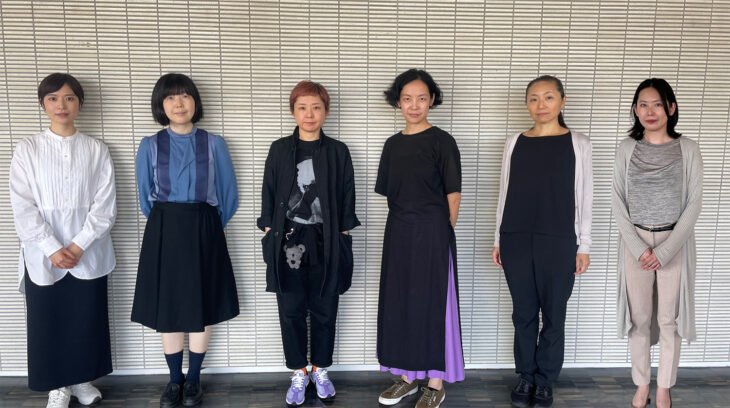
Planning members of the “Women and Abstraction” exhibition. From left: Kobayashi Sayuri, Yokoyama Yukiko, Hotta Aya, Ogawa Ayako, Matsuda Takako, and Sahara Shiori.
Photo by Tokyo Art Beat
Rediscovering and reevaluating the collection
—— Recently, abstract expression by female artists has been reevaluated internationally. This is a very timely project that corresponds to the current situation, but what was the intention behind it?
Ogawa Ayako: I was the initiator of the proposal after checking the exhibition trends of “The Herstory of Abstraction in East Asia” at Taipei Fine Arts Museum in 2019, “Elles font l’abstraction” at Centre Pompidou in Paris, held from 2021 to the following year, the traveling exhibition “Women in Abstraction” at Guggenheim Museum Bilbao in Spain, and the “Labyrinth of Forms: Women and Abstraction, 1930–1950” at the Whitney Museum, which was held in the same year. The National Museum of Modern Art, Tokyo (MOMAT) has many wonderful abstract works by women artists in its collection, so I wanted to showcase not only paintings but also sculptures and photographs.
Yokoyama Yukiko: The decision to work on that theme itself was unanimous. After that, we decided to form a team to not only ride the global wave of re-evaluation of female artists, but also to continue our research and planning in the future. Usually, one or two people are in charge of small collection projects like this, but this time it was decided to be planned by six female staff members.
Ogawa: The exhibition is divided into three sections in order to show the trajectory of abstract expression. The theme of Section 1 is the Women Artists Association established in 1946, where Migishi Setsuko (1905–99), Katsura Yuki (Yukiko) (1913–91) and others were active. Proliferating Circles in Section 2 focuses on the motif of “circles,” while Section 3, Suppression and Liberation, focuses on the processes and acts of creation. Each section is curated by setting keywords.
Yokoyama: Three of the members, including Ms. Kobayashi, specialize in photography, so about half of Section 3 consists of photographic works.
Ogawa: Photographs are essentially real images, so Ms. Matsuda, Ms. Hotta, and Ms. Kobayashi, who were in charge of the exhibition, had a hard time choosing the abstract photographs for this exhibition.
Kobayashi Sayuri: It is rare to find photographs that are 100% abstract. For example, Haruki Maiko’s “outer portrait” series featured in this exhibition is an abstract work in which the subject is a person, but the exposure and other factors are adjusted to create an abstract image.
—— A retrospective exhibition of Kinoshita Kazuyo (1939–94) and Yoshikawa Shizuko (1934–2019) introduced in Section 3 will be held at the Nakanoshima Museum of Art, Osaka in fiscal year 2024. Fukushima Hideko (1927–97), exhibited in Section 2, has also been seen in several exhibitions this year, and I feel that it is receiving increasing attention. Could this exhibition be the first step in MOMAT’s continued efforts to address this trend of re-evaluating female artists?
Yokoyama: I think so. In the past, we have featured female artists several times in the MOMAT collection. In 2019, “Emancipation of Humanity: Focusing on Works by Female Artists” (person in charge of exhibition planning: Hosaka Kenjiro, current director of Shiga Museum of Art) was held.
Additionally, the increase in the proportion of female researchers at MOMAT over the past two to three years may be a positive tailwind. Normally, in the Highlights section (Room 1, 4th floor of MOMAT), 90–100% of the works exhibited are by male artists, with a focus on important cultural properties. In the spring of 2023, in this room, we have achieved an equal number of male and female selections, including works that have not been widely shown until now (reference review [in Japanese]). Important cultural properties from the collection were on display at the exhibition “Secrets of Important Cultural Properties” held at the same time (March 17 to May 14, 2023). We considered this a good opportunity and took this Highlights exhibition as the first step toward future research and collection of artworks.
During the following exhibition, we presented for the first time the newly acquired work Kaeri-michi (Way back) (1915) by Ikeda Shoen (1886–1917), a female Japanese-style painter. On this occasion, we held an exhibition featuring only female Japanese-style painters.
However, the reality is that from the pre-war period to the immediate post-war era, there wasn’t much information about female artists, so it would be difficult to pick up on them unless you were very conscious of them. Some of the works introduced in this exhibition “Women and Abstraction” have rarely been exhibited in the museum since they were stored. For example, Fujikawa Eiko (1903–83) was one of the founders of the Women Artists Association. She is a very important artist, and this is the first time that her work, Mass (1959), has been exhibited since they were acquired.
—— So this exhibition is also rediscovering and reexamining collections that have been overlooked so far?
Yokoyama: That’s right. Works by female artists are often collected as donations from the artists themselves or their families, and the fact that museums do not actively collect them may be one of the reasons why they have not been well received. Fujikawa’s works have also been transferred from the Ministry of Education (currently Ministry of Education, Culture, Sports, Science and Technology, MEXT) to the MOMAT collection.
Ogawa: Vase (1946) and Flowers (1947) by Sakurai Hamae (1908–2007), who was also active in the Women Artists Association, and Void II (1960) by Tanaka Tazuko (1913–2015) have rarely been exhibited other than on loan to exhibits outside MOMAT.
Yokoyama: At MOMAT, we change the collection exhibition rooms several times a year, and each exhibition room has its own theme. The fact that the themes tend to be tied to social and political events such as disasters and wars may also be a factor in why female artists are less likely to be featured.
Furthermore, the abstract expressions of female artists are far removed from the abstract expressions that have developed in male-dominated art history. This time, I wanted to break away from such historical frameworks and expand the framework of abstract art more freely.
The works of Fujikawa and Tanaka Atsuko are abstract to anyone who looks at them. Sakurai’s works depict vases and flowers, but they are also very abstract if you focus on their matière (materials and materials of works of art). From such perspective, I tried to expand the scope of “abstraction” a little. In Section 1, rather than looking at commonalities in terms of form as in Sections 2 and 3, I decided to summarize them as people who were creating in solidarity at a time when it was difficult for women to become independent artists.
Gender balance in the collection
—— What do you think about the gender balance of your collection? Noji Chiaki, who is now at Tokyo Art Beat, and I worked on a series of articles when we were at Bijutsu Techo (Art Notebook, a monthly art magazine) in 2019 in which we investigated the gender balance of major art museum collections. According to the article [in Japanese] from that time, 81% of MOMAT’s collections are works by male artists, while only 13% are by female artists. If you look at the numbers, the gender balance is definitely imbalanced.
However, looking at MOMAT’s new collections in recent years, I get the impression that works of female artists are actively being collected. Currently, new acquisitions such as Endo Mai x Momose Aya’s “Love Condition” (2020) and Kazama Sachiko CEMENT MORI (2020) are prominently displayed in the MOMAT Collection, which is located on the same floor as the exhibition “Women and Abstraction.”
Yokoyama: The medium-term plan for 2021–25 compiled by the Independent Administrative Institution National Museum of Art officially states that works will be secured while always taking into account “contemporarily important perspectives such as gender balance and locality.” Awareness is certainly increasing, and in fact in recent years there has been an active effort to collect works by female artists.
Recently, MOMAT’s special exhibitions have been dominated by men, including Gerhard Richter (1932–), Ohtake Shinro (1955–), Antoni Gaudí (1852–1926) and Munakata Shiko (1903–1975). We have been talking about wanting to hold solo exhibitions of female artists in the near future. However, when it comes to special exhibitions, the number of people attending is a strict goal.
Also, although there are many active female artists in modern times, MOMAT is a “modern” museum, so the span of history it covers is quite long, and there are still many male artists who should be introduced. There are some frustrating parts.
Breaking away from patriarchal commentaries
—— It’s interesting that leaflets were distributed at the venue of this exhibition, and they included a roundtable discussion with six of the organizers. I felt everyone’s enthusiasm for this exhibition. According to this, you have written sixteen new commentaries to be attached to the exhibited works?
Yokoyama: Yes. Since its renewal in 2012, explanations for the works displayed at collection exhibitions have been written in a highly versatile style by the person in charge at the time, and all have been kept in stock for future use. However, many of the works exhibited in “Women and Abstraction” had never been exhibited before, and there was almost no explanation left.
Ogawa: Even when there were commentaries, some of them were written in a patriarchal context, referring to the existence of male partners or fathers who were also artists. We decided that such content could not be overlooked in this project, so we divided up the work and rewrote it anew. Until the early 2010s, this kind of gender consciousness was lower than it is today, and as a researcher, I may have been tempted to write about female artists when their partners were well-known artists. But this time, I focused on the artist and her work to the greatest extent possible.
Yokoyama: It was a great opportunity to research the artists and their works once again.
Also, at the beginning of the project, I had the idea that it would be interesting to compare the critiques of the work at the time with the commentary we have written today. However, as I continued my research, I found that although female artists were often talked about in the framework of “female artists and female painters” during the same period, I found almost no criticism of their works themselves.
Ogawa: As I continued my research, I discovered an article published in the December issue of Bijutsu Techo in 1967, which was even more amazing. It was a roundtable discussion titled “Top Ladies of the World Art World and Their Conditions.” An art critic Tono Yoshiaki (1930–2005), Katsura Yuki, whose work is on display this time, and printmaker Nonaka Yuri (1938–) were the participants. Tono’s perception of female artists was extremely biased. He said, “(Women) have little intuition or inspiration,” and “women may not have the ability to create history.” Finally, he concluded, “Rather than the exhibition ‘Women Artists Association,’ why not hold a judging panel for female artists? Let’s have all the female artists wear swimsuits, have them bring in their works, and explain them to us. Have a cup of tea together… I think it would be great if we could have an opportunity to judge all the women artists themselves. I wonder if I will be scolded for saying this.” When all the planners circulated it and read it, we were surprised and thought, “This is terrible!”
Yokoyama: It was so shocking that I decided to photocopy all the pages and display them as a document that gives a glimpse of the gender sensibility of the time (laughs).
—— Magazines from the time are often displayed as materials, but usually you only see the cover or an opening inside, but this time you displayed the entire article so that visitors could read it. I could really tell that the planners wanted visitors to read the content (laughs).
The importance of continuing the investigation
Ogawa: We have received a variety of reactions since the exhibition began, but I feel a little frustrated that people tend to see it as an exhibition that incorporates trends. Re-evaluating and reviewing female artists is an urgent issue, and we are determined to continue working on it, but sometimes we feel that it is not getting the word across.
Yokoyama: We may have no choice but to demonstrate this by continuing our activities. There is a long history of gender asymmetry, and we are currently in a period of transition where there is a growing movement to correct this. In another 10 to 20 years, a framework such as “group exhibitions of women artists” may no longer be effective. In order to create such a future, I think it is extremely important that each museum conducts research and exhibits from a variety of angles while keeping a gender perspective in mind.
Kobayashi: Previously, at a meeting within MOMAT, we reflected on the current situation in which museums around the world are actively engaging in initiatives related to feminism and gender. The topic of discussion was how MOMAT should respond to this situation. Before arriving at MOMAT, I was studying at a graduate school. In my course, there are a certain number of students who conduct art history research and criticism from the perspectives of feminism and gender, so this approach was natural. I hope that by continuing my activities, I can gradually bring about this kind of situation at art museums.
—— I am very much looking forward to the future development of this project. I also see sustainability in the fact that you have a team of six people working on this project, rather than a single motivated person working alone.
Yokoyama: This time, all of the male staff members happened to be busy, so there were only female members. However, in the future, we would like to continue as a team of six people, with the participation of men as well.
Translated from “Tokyo Kokuritsu Kindai Bijutsukan wa naze ‘Josei to Chusho’ ten wo Kaisaisurunoka (Why is the National Museum of Modern Art, Tokyo holding the exhibition ‘Women and Abstraction’?),” Tokyo Art Beat, 20 October 2023. (Courtesy of Art Beat, Inc.) [December 2023].
Keywords
- Fukushima Natsuko
- Tokyo Art Beat
- National Museum of Modern Art, Tokyo
- MOMAT
- Ogawa Ayako
- Yokoyama Yukiko
- Kobayashi Sayuri
- abstraction
- abstract expression
- women
- gender balance
- art
- female artists
- painting
- sculpture
- photography
- Women Artists Association
- Bijutsu Techo
